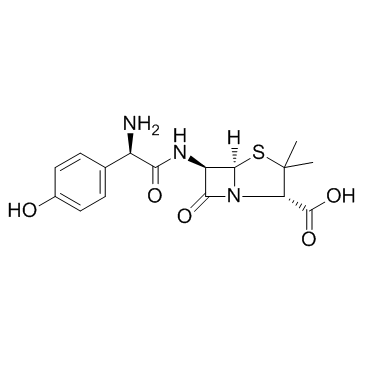Amoxicillin

Amoxicillin structure
|
Common Name | Amoxicillin | ||
|---|---|---|---|---|
| CAS Number | 26787-78-0 | Molecular Weight | 365.404 | |
| Density | 1.6±0.1 g/cm3 | Boiling Point | 701.8±70.0 °C at 760 mmHg | |
| Molecular Formula | C16H19N3O5S | Melting Point | N/A | |
| MSDS | Chinese USA | Flash Point | 378.2±35.7 °C | |
| Symbol |

GHS08 |
Signal Word | Danger | |
|
Experimental study of the impact of antimicrobial treatments on Campylobacter, Enterococcus and PCR-capillary electrophoresis single-strand conformation polymorphism profiles of the gut microbiota of chickens.
J. Med. Microbiol. 63(Pt 11) , 1552-60, (2014) An experiment was conducted to compare the impact of antimicrobial treatments on the susceptibility of Campylobacter, Enterococcus faecium and Enterococcus faecalis, and on the diversity of broiler microbiota. Specific-pathogen-free chickens were first orally... |
|
|
Chemical composition, antibacterial and antioxidant activities of six essentials oils from the Alliaceae family.
Molecules 19(12) , 20034-53, (2014) Six essential oils (EOs) from the Alliaceae family, namely garlic (Allium sativum), onion (Allium cepa), leek (Allium porrum), Chinese chive (Allium tuberosum), shallot (Allium ascalonicum) and chive (Allium schoenoprasum) were characterized by GC and GC-MS a... |
|
|
Cheminformatics analysis of assertions mined from literature that describe drug-induced liver injury in different species.
Chem. Res. Toxicol. 23 , 171-83, (2010) Drug-induced liver injury is one of the main causes of drug attrition. The ability to predict the liver effects of drug candidates from their chemical structures is critical to help guide experimental drug discovery projects toward safer medicines. In this st... |
|
|
Translating clinical findings into knowledge in drug safety evaluation--drug induced liver injury prediction system (DILIps).
J. Sci. Ind. Res. 65(10) , 808, (2006) Drug-induced liver injury (DILI) is a significant concern in drug development due to the poor concordance between preclinical and clinical findings of liver toxicity. We hypothesized that the DILI types (hepatotoxic side effects) seen in the clinic can be tra... |
|
|
Developing structure-activity relationships for the prediction of hepatotoxicity.
Chem. Res. Toxicol. 23 , 1215-22, (2010) Drug-induced liver injury is a major issue of concern and has led to the withdrawal of a significant number of marketed drugs. An understanding of structure-activity relationships (SARs) of chemicals can make a significant contribution to the identification o... |
|
|
A predictive ligand-based Bayesian model for human drug-induced liver injury.
Drug Metab. Dispos. 38 , 2302-8, (2010) Drug-induced liver injury (DILI) is one of the most important reasons for drug development failure at both preapproval and postapproval stages. There has been increased interest in developing predictive in vivo, in vitro, and in silico models to identify comp... |
|
|
Simultaneous determination of 38 veterinary antibiotic residues in raw milk by UPLC-MS/MS.
Food Chem. 181 , 119-26, (2015) A selective and rapid method has been developed to determine, simultaneously, 38 veterinary antibiotic residues in raw milk by ultra-high-performance liquid chromatography-tandem mass spectrometry (UPLC-MS/MS). One milliliter of raw milk was diluted with 0.5 ... |
|
|
Simple and accurate quantitative analysis of 20 anti-tuberculosis drugs in human plasma using liquid chromatography-electrospray ionization-tandem mass spectrometry.
J. Pharm. Biomed. Anal. 102 , 9-16, (2014) A simple and accurate liquid chromatography (LC)-tandem mass spectrometry (MS/MS) method for the quantitation of 20 anti-tuberculosis (anti-TB) drugs in human plasma, was developed as a tool for therapeutic drug monitoring. Two protein precipitation methods w... |
|
|
Nanodiamond-Gutta Percha Composite Biomaterials for Root Canal Therapy.
ACS Nano 9 , 11490-501, (2015) Root canal therapy (RCT) represents a standard of treatment that addresses infected pulp tissue in teeth and protects against future infection. RCT involves removing dental pulp comprising blood vessels and nerve tissue, decontaminating residually infected ti... |
|
|
Inhibitory and bactericidal activity of selected South African honeys and their solvent extracts against clinical isolates of Helicobacter pylori.
Pak. J. Pharm. Sci. 26(5) , 897-906, (2013) The growing problem of antibiotic resistance by Helicobacter pylori demands the search for novel compounds, especially from natural sources. We evaluated the anti-H. pylori activity of six local honeys at different concentrations as well as their solvent extr... |